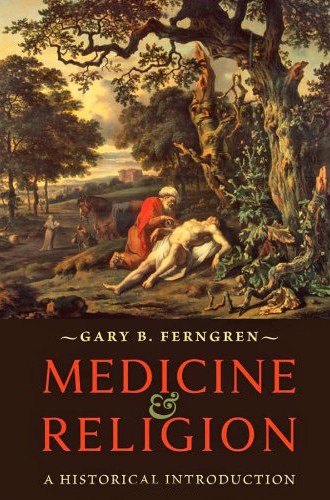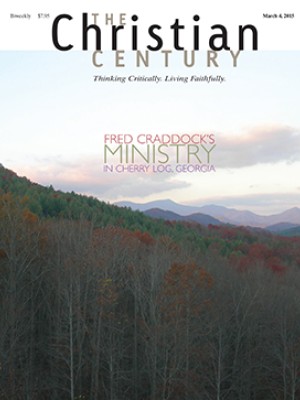Medicine and Religion, by Gary B. Ferngren
The Cincinnati hospital where I work was founded in the 19th century by women of the Episcopal diocese to provide medical and surgical care for local children, but it has since become a large, secular research facility. Internationally known for its subspecialty research and practice innovations, the hospital receives referrals from around the globe. I have yet to meet a patient who came for the spiritual environment, though the hospital’s pastoral care division employs chaplains of various faiths and denominations who are highly trained in theology, counseling, and the use of sophisticated assessment tools. Although some families develop therapeutically valuable relationships with pastoral care staff, what gets them in the door is our clinical competence in the applied science of medicine. Everything else is value-added.
Gary Ferngren’s handy new volume on the history of religion and medicine in the West reminds the reader how new and odd this is. From the time of the ancient Near East until very recently in the economically developed countries of the Global North, the categories we now call religion and medicine were intricately related and often inseparable. But to the degree that the relationship between religion and medicine was acknowledged during my undergraduate and medical education, it was viewed as a tale of scientific progress triumphing over religious obscurantism. Using considerable recent scholarship that calls that Whiggish narrative into question, Ferngren reveals a richer, more interesting story.
Read our latest issue or browse back issues.
Before surveying 40 centuries in a geographical area stretching from Mesopotamia to North America, Ferngren announces that his book is “neither a history of medicine nor a history of religion, . . . but rather an introduction intended for nonspecialists.” As such, the book serves the interested novice while leaving much for scholars to quibble with.
What Ferngren does well is considerable. He recognizes that the “imaginative gulf” separating us from our predecessors obscures continuing challenges that technology and scientific control are unlikely to eliminate or solve: our own pain and suffering, our response to such things in others, and the question of how to make meaning in the presence of bodily limitations. Yet he also knows that most of what we moderns consider universal attitudes toward suffering and care are, in fact, historically contingent.
Ferngren begins his survey in the ancient Near East with the civilizations of Mesopotamia, Egypt, Israel, and the Hellenistic period. Buttressed by written documents and archaeological evidence, his narrative stresses complexity over uniformity across and within these cultures. If he perhaps devotes excessive attention to distinguishing between “religious,” “magical,” and “natural” medicine—as if such categories are unproblematic, transhistorical, and transcultural—he nevertheless demonstrates that ancient medicine was more than just charms and incantations.
Ferngren identifies fifth-century BCE Greece as the location and moment when medicine became a science as well as a craft. Greek medicine and syncretistic polytheism dominated the Hellenic, Hellenistic, and Roman Mediterranean. Another critical point came with the advent of Christianity, which built on a Jewish understanding that all humans are created in the divine image and that service to others—especially the poor—is a religious imperative. Ferngren demonstrates that Christian philanthropy, from the founding of the first true hospitals to Christians’ life-saving ministrations to plague victims when wealthy non-Christians (including the famed physician Galen) fled for their safety, transformed the way persons in late antiquity understood what we might now call access to health care.
A chapter on medieval European medicine debunks several myths: that Christian Europe primarily saw illness as divine punishment or the work of demons, that the church banned scientific dissection, and that Christians systematically destroyed ancient medical texts that were considered pagan. Hospitals and centers of learning thrived in the Christian East, and monasteries were the conduits and repositories of medical texts, learning, and practice in the West until the formation of the first European medical schools around 1200. Human dissections were documented by the end of the 13th century.
Ferngren’s treatment of Islam, without which any history of Western science or medicine is woefully incomplete, is informative if far too short, sacrificing depth for scope. If Ferngren wants to leave his readers wanting more, he’s successful in general, but particularly here.
When he returns to Europe to discuss early modernity, he relies heavily on the Reformation as his unifying conceptual theme, conflating Protestant Reformers with humanists (like Erasmus, a Catholic) and early modern scientists (like Copernicus, also a Catholic), regardless of confession, ecclesiology, or motivation. When Ferngren considers Catholics as such, as in a brief section on Tridentine Catholicism, his focus is on institutional responses to Protestantism. The Enlightenment comes almost as an afterthought. Although I understand that an author must make compromises when covering so vast a history, in this discussion I found myself more frustrated than newly informed and desiring more.
The chapter on the 19th and 20th centuries concentrates increasingly on North American developments, with brief considerations of Reform Judaism, renewed interest in miraculous healing among some Protestants, novel ethical challenges, and the growth of a secularized, professionalized, and bureaucratized health-care system. Ferngren then offers brief reflections on his whirlwind tour of four millennia in an epilogue, which includes the most tantalizing evaluations in the volume. Here he writes:
Compassion is a quality that is fully compatible with scientific medicine and with progress in medical technology, but it is not one that grows naturally out of either. It is the desire to treat the sick patient, not in a medically competent and professional manner alone, which was the Greek practice, but knowingly and tenderly as a human being who bears the image of God.
Ferngren may be on to something, and I would like to see him better develop this idea, building it up from the historical record—including primary sources—rather than merely asserting it in an epilogue. Once again, he leaves the attentive reader wanting more. I hope he provides that in subsequent work.







